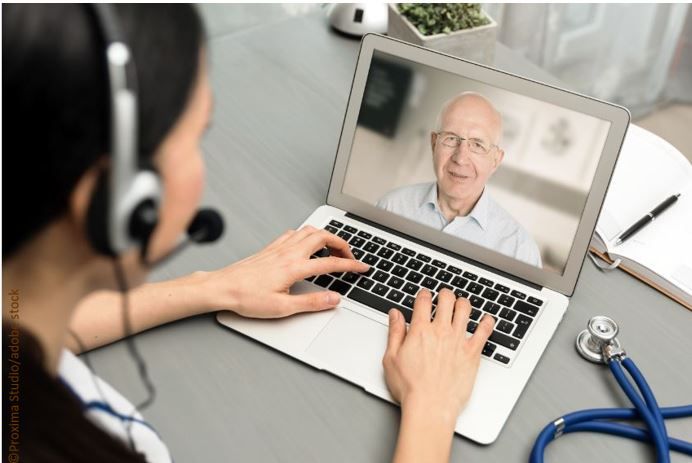- Clinical Technology
- Adult Immunization
- Hepatology
- Pediatric Immunization
- Screening
- Psychiatry
- Allergy
- Women's Health
- Cardiology
- Pediatrics
- Dermatology
- Endocrinology
- Pain Management
- Gastroenterology
- Infectious Disease
- Obesity Medicine
- Rheumatology
- Nephrology
- Neurology
- Pulmonology
Telehealth Popularity May Not Stand the Test of Time: New Report
Telehealth use is waning consistently from its peak use during the pandemic, raising the question of what the future holds for virtual care.
In the early months of the COVID-19 pandemic many patients used telehealth for the first time, often because it was the only option available if they wanted to see a provider.
Telehealth use is down substantially from its pandemic peak, however, and a new report from Trilliant Health examining trends in health care poses questions about how much consumers want to utilize virtual care.
Consumers are clearly embracing telehealth for behavioral needs, the report states, a finding consistent with other research. Outside of behavioral health, though, some consumers are exhibiting reluctance to see providers virtually. Some patients and providers seem to prefer in-office visits.
©Proxima Studio/stock.adobe.com

Telehealth volume peaked with 76.6 million visits in the second quarter of 2020 and dropped to 41.5 million visits in the fourth quarter of 2022. While telehealth use remains far higher than it was before the pandemic, virtual visits have dropped 45.8% since the peak.
Nearly half (49%) of patients who have used telehealth have only engaged in virtual care once, the report notes.
Sanjula Jain, Trilliant Health’s chief research officer, thinks that the frequent one-time use of telehealth merits attention.
“Did they just use it one time because they had no choice or they didn't have a great experience, or they have to do that follow-up visit, so they said, why even bother? I think that these are all potential explanations,” Jain said in an interview with Chief Healthcare Executive®, a sister publication to Patient Care.®
“Did they just use it one time because they had no choice or they didn't have a great experience, or they have to do that follow-up visit, so they said, why even bother? I think that these are all potential explanations.”
In addition, some patients who are using telehealth eventually opt for in-person appointments anyway. Excluding behavioral health, roughly 3 in 10 (29.2%) virtual visits were followed by the patient having a follow-up appointment for the same reason within three weeks, according to the report.
The number of follow-up appointments after telehealth visits is significant, Jain says.
“If they're going to follow up for the same thing, I think it really begs the question about how effective are some of these virtual care modalities, in terms of being able to diagnose a patient or check, physically touch them, or actually cater to their needs,” Jain says. “And I think that is increasingly going to be something that folks across the industry will, I hope, start recognizing.”
Jain also says some doctors would prefer to see patients in person.
“It seems that physicians in particular are starting to say, ‘During the peak of the pandemic, we had no other option, and it was convenient, and it worked. But now that we have choices, it's not the same level of care administration, and it's more transactional. We can't really build a relationship.’”
Most doctors have used telehealth, at least occasionally. Four out of five doctors (80%) engaged in telehealth visits in 2022, up from 14% in 2016, according to the American Medical Association.
Patients are turning to telehealth to see mental health providers. Nearly two-thirds (62.8%) of telehealth visits in the fourth quarter of 2022 were for behavioral health appointments, which represents a sizable increase from the 41.8% level during the first quarter of 2020.
“I think from an access point of view, we see that the most frequent users of telehealth are using it for behavioral health,” Jain says.
Nearly two-thirds (62.8%) of telehealth visits in the fourth quarter of 2022 were for behavioral health appointments, which represents a sizable increase from the 41.8% level during the first quarter of 2020.
The frequent use of telehealth for behavioral health visits makes sense for patients who have built relationships with their providers, Jain says. A patient regularly seeing a psychiatrist may opt for virtual appointments when they are traveling, rather than miss a session because they can’t meet in person.
Still, enthusiasm for telehealth among employers has dipped, according to the Business Group on Health, a nonprofit group representing large employers. Most employers say they see value in telehealth, but the number who said virtual health is essential to their overall health care strategy dropped from 85% in 2021 to 64% this year, the group said.
Telehealth certainly has a place in health care, but Jain says it’s important to understand that it may not prevent some patients from needing to see providers in the office. The point of this report was really to say, ‘this is something that is important to think about in terms of friction cost and the friction experience,’” she says.
Source: 2023 Trends Shaping the Health Economy Report. Trilliant Health. Accessed September 20, 2023. https://www.trillianthealth.com/reports/2023-health-economy-trends
